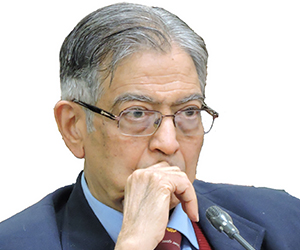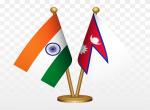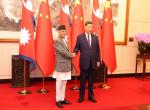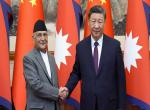Sheikh Hasina's four day state visit to India from January 10-13 has set the seal on the process of an upgradation of India-Bangladesh ties.
The single major impediment to warm and friendly relations between the two countries, following Shaikh Mujibur Rahman's assassination in August 1975, has been Bangladesh's accord of sanctuary and support to anti-Indian insurgent groups like the United Liberation Front of Assam, patronisation of Islamic fanatical forces with cross border ramifications and collusion with Pakistan's Inter Services Intelligence in promoting terrorism in India. Such actions may be attributed to the anti-Indian and obscurantist mindset of the military juntas and the Bangladesh National Party which were in control of developments in Bangladesh from 1975 to 2008, barring the Awami League interlude from 1996 to 2001.
Hasina was not particularly mindful of India's security concerns during her 1996-2001 tenure as prime minister. This may, perhaps, be attributed to the fact that she had only a bare majority in Parliament, was new to office, and had to constantly to look over her shoulder in taking on the well entrenched forces in Bangladesh inimical to India.
Her second term in office commencing in January 2009, promises, however, to be quite different. Having secured 230 seats on its own and 262 seats along with allies in a 300-member Parliament she has an overwhelming mandate to stamp out fanatical elements supporting terrorism.
Her resolve to do so has been amply demonstrated by the actions already taken by her in this direction notably revival of the prosecution of the killers of Rahman, on whom the death sentence has since been confirmed, resumption of the trial of the 1971 war criminals, the decision to enact the Vested Property Return (amendment) Act 2009, enabling return of Hindu properties confiscated during the 1965 India-Pakistan war, and efforts at banning religion based politics.
Similarly, in fulfillment of her assurance soon after her election victory in December 2008 that no one would be allowed to use Bangladesh to "carry out terrorism in India", it is significant that Hasina has effectuated the rendition to India of prominent ULFA leaders such as Arabindo Rajkhowa, Raju Baruah, Chitraban Hazarika and Sasha Choudhary as well as two LeT operatives who had been provided sanctuary in that country.
India, in turn, has been sensitive to the changed situation in Bangladesh with the advent of the Awami League government and has quietly, but effectively, missed no opportunity to reach out to it. On water sharing India has provided assurances that it would not do anything which would harm Bangladesh, on issues of transit to Bhutan and Nepal it has been accommodative, on Bangladesh's adverse trade balance it has shown a willingness to ameliorate the situation and, above all, when regime survival was at stake, during the February 2009 Bangladesh Rifles mutiny, it threw its full weight behind the government helping it tide over the crisis.
In view of the foregoing, and the meticulous preparations that went into the visit, including extensive ministerial and official level exchanges, it is no surprise that it has been highly successful and is being variously termed as 'historic', 'game changing', and 'path breaking'. This is reflected in the veritable meeting of minds of the two sides on a variety of issues detailed in the lengthy joint communiqué issued on January 12. Apart from the accords signed on mutual legal assistance in criminal matters, combating international terrorism and organised crime and illicit drug trafficking, transfer of sentenced persons, power sector cooperation and a cultural exchange programme, the following are some of the major understandings and decisions arrived upon:
- A vision for the future in pursuit of the common good -- bilaterally, regionally and globally. All issues to be resolved through cooperation and mutual understanding.
- A comprehensive programme of development cooperation between the two countries to be put in place including in the areas of water resources, power, transportation and connectivity, tourism and education.
- Need for both countries to actively cooperate on security issues and ensure that the territory of either is not used for activities inimical to the other.
- Facilitation by India of road and rail connectivity for Bangladesh with Nepal and Bhutan and Bangladesh's agreement to allow India use of Chittagong and Mongla ports, to develop the Akhaura-Agartala rail link, and to use Ashuganj on the inland waterway for improved India's connectivity with the north east.
- Supply of 250 MW of power to Bangladesh from India's grid and need to expedite intergrid connectivity.
- A $1 billion line of credit by India for a range of infrastructure projects in Bangladesh as per the latter's requirements.
- Offer of 300 scholarships to Bangladesh annually for 5 years for study and training in Indian universities and institutions in a wide range of disciplines as required by scholars and persons in government employment.
- Measures not merely to promote Bangladeshi exports to India but also its investments, as well as Indian investments in Bangladesh.
- Joint celebrations of the 150th birth anniversary of Rabrindranth Tagore
Some may, of course, argue that many other important issues such as sharing of the Teesta waters, illegal Bangladeshi migration, closure of camps of Indian insurgent groups in Bangladesh, redressal of Bangladesh's adverse trade balance vis a vis India, settlement of the maritime boundary, land border settlement etc have not been resolved.
In this context, it needs to be noted that in respect of most of the unresolved issues the modalites for their resolution have been put in place. For instance, on the sharing of the Teesta waters, and issues relating to some other rivers, the ministerial level joint rivers commission is to meet in the first quarter of this year. Similarly, on the maritime boundary the visit of a Bangladesh delegation to India is being scheduled and on the land boundary a joint boundary working group is being convened to take the process forward in the spirit of the 1974 Land Boundary Agreement.
The point to be noted is that such sensitive and complex issues do not have any easy solutions. These are often only found through mutual give and take which comes much more easily once trust and confidence is established at the highest level.
Hasina's visit seems to have served to establish such trust and confidence and the personal rapport between the two leaderships is poised to propel the relationship between the two countries to a much higher plane.
This is evident not only from the warm references by Prime Minister Manmohan Singh to Hasina as a 'valued friend' and his assertions that India attached the 'highest priority' to relations with Bangladesh but also by the doubling of the Indian economic assistance programme, from the originally envisaged level of $500 million, and his assurances that the India would do nothing on the Tipaimukh project 'that would impact Bangladesh adversely.'
In addressing the plethora of thorny bilateral issues that still confront India and Bangladesh, the former must appreciate that the opposition in Bangladesh, aided by fanatical fundamentalist forces, is gunning for the Awami League. Indeed, on the eve of Hasina's visit the opposition threatened to launch a movement against her if she returned from India empty handed.
A former Director General of the Bangladesh Rifles went so far as to suggest that Bangladesh should be prepared to wage an all out war if any decision is taken in disregard of its interests. At the conclusion of the talks between the two leaderships the BNP Secretary General Khandekar Delawar Hassan is reported to have dubbed the outcome as a 'total failure'.
India, therefore, needs to be as forthcoming as possible, within, of course, the constraints imposed by its own domestic constitutencies, in meeting the legitimate requests of the Bangladesh government with a view to strengthening its hand against the forces inimical to it as these forces are also inimical to us.
The Bangladesh leadership, on its part, must recognise that if, through its acts of omission and commission, India's core security concerns are adversely affected, the latter's ability to go the extra mile in addressing Bangladesh's concerns cannot but be affected.
Happily, there is today regime compatability between India and Bangladesh on this issue as India's core security concerns arise from the same elements that seek to unseat Hasina. The latter has wisely recognised this and in boldly striking at fanatical and terrorist elements, which pose a threat to India and Bangladesh, has acted with far greater maturity than the Pakistani leadership which continues to nurture jihadi groups even though these also pose a threat to Pakistan's own long term well being.
In these circumstances, the current leadership in India and Bangladesh is well placed to establish a meaningful and mutually cooperative relationship between the two countries.
Satish Chandra is former deputy national security advisor and currently Distinguished Fellow, Vivekananda International Foundation.










Post new comment